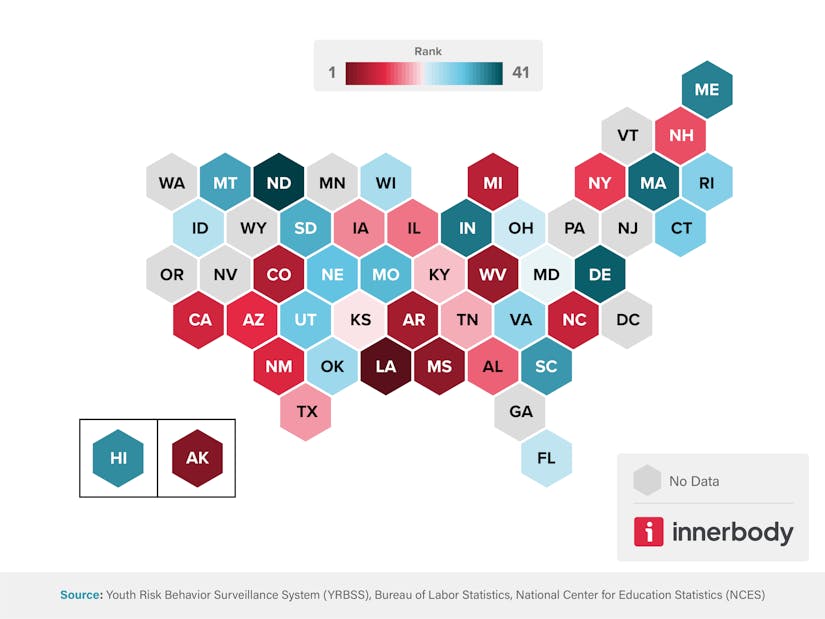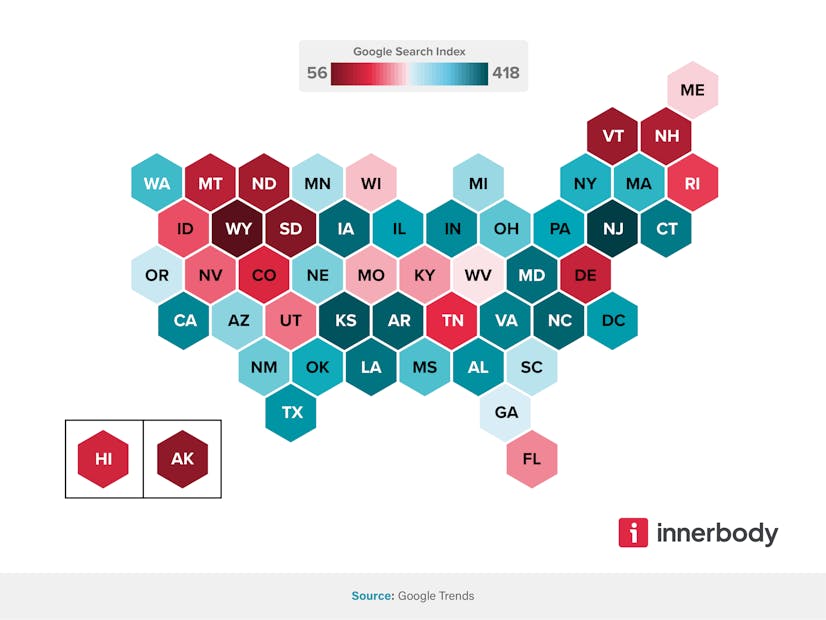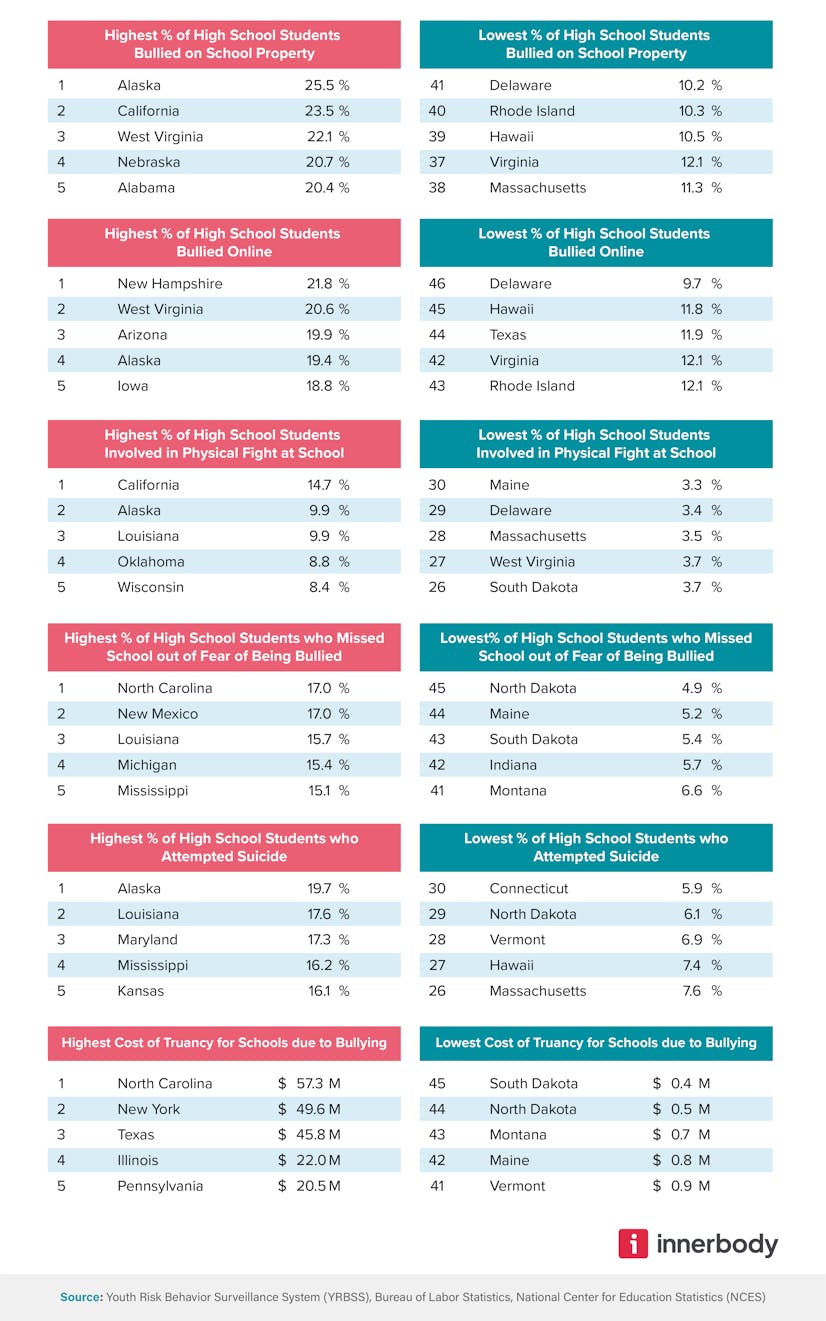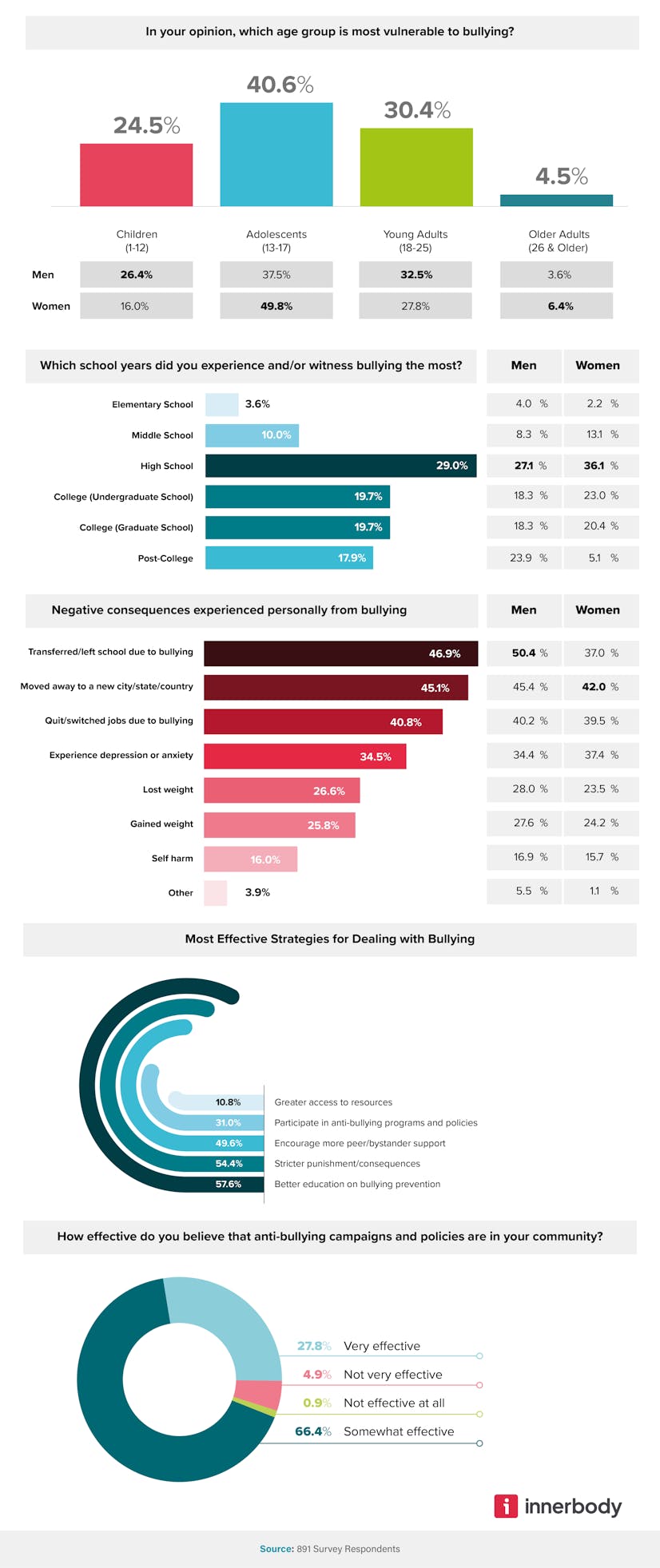Which U.S. States Struggle Most With Bullying?
We analyzed data and conducted a survey to rank them.

Bullying is a widespread problem in the U.S., with 1 in 5 high school students reporting being bullied on school property.1 When people think of bullying, they often picture pushing and shoving, but this behavior can take on many forms outside of physical intimidation. Bullying can also look like verbal insults, mockery, sexually suggestive comments, spreading rumors, exclusion from groups, and cyberbullying.
No matter what type of bullying you experience, the consequences can be dire for your physical and mental health. We analyzed bullying trends nationwide and surveyed 891 people to learn about their perceptions and experiences.
Jump to:
Key takeaways
- Alaska has the highest percentage of students being bullied on campus and attempting suicide from being bullied.
- More bullying is reported in the South than in any other region of the U.S.
- 62% of survey respondents said they “always” or “often” see hurtful comments on social media.
- Around 29% of those bullied experience it in high school, but 20% of college students are also victims of bullying.
- A majority of people (90%) believe that anti-bullying policies are at least somewhat effective.
Overview
In this study, we aimed to support Bullying Prevention Month by creating a state ranking to understand which states are struggling the most with bullying and which appear to be successfully addressing it. We utilized a variety of data sources and collected survey responses to understand the extent of the bullying issue across the United States.
Where in the U.S. is bullying most common?

Photo by Innerbody Research
When examining the prevalence and impact of bullying across the U.S., we considered the number of physical fights on school property, general bullying on school property, online bullying, attempted suicide, and truancy. Overall, there were trends revealing that northern states have less bullying than other regions, and southern states struggle with higher rates of bullying. In fact, half of the states with the most troubling bullying data were located in the South, including states like Louisiana, Mississippi, and Alabama.
This begs the question, are there stricter bullying policies or better proactive education programs in place in the northern region of the U.S.? And is that really the reason why bullying rates are better there? While it can be difficult to say for sure, a 2015 research study suggests that anti-bullying policies are, in fact, effective intervention strategies that reduce the risk of being bullied in schools.2
There is no federal legislation regarding bullying in the U.S.; this responsibility falls on the shoulders of each of the 50 states.3 While the U.S. Department of Education provides a framework, the individual states set their own anti-bullying laws, policies, and regulations.4 This means there can be quite a bit of variation between states regarding the consequences of bullying behavior. Even the definition of bullying itself varies from state to state, but there are, at the very least, school policies in place in all 50 states. It’s also worth noting that sometimes bullying crosses over into discriminatory harassment; in that case, there are federal laws in place to protect you.5
Louisiana, Alaska, and Mississippi were the top three worst states overall for bullying issues, highlighting several areas of concern — physical fights, bullying online, and attempted suicides. California had the worst rate of on-campus bullying behind Alaska, which could be due to the state’s high student-to-counselor ratio. This suggests that students in California may have limited access to mental health support at school.
On the other hand, North Dakota technically won overall due to having some of the lowest rates of bullying-related truancy and suicide attempts, along with a fairly low incidence of cyberbullying. However, Delaware was the state with the lowest levels of bullying across the board but had higher rates of bullying-related truancy and suicide attempts than North Dakota.
Full rankings data of the states for bullying
Here is a table showing how states compare overall and for specific statistics related to bullying. Note that data was unavailable for some states, which we subsequently omitted from the table.
Which states are most concerned?

Photo by Innerbody Research
A look at Google search analytics reveals that states with the lowest bullying rates (typically found in northern states) also had the least amount of interest in searching for bullying support or help online. For example, states like South Dakota, Montana, Hawaii, Delaware, and North Dakota all ranked in the bottom 10 for both bullying and searching the internet for bullying solutions. Perhaps this is due to these states having effective bullying prevention strategies in place, negating the need for residents to seek out information online.
The correlation doesn’t end there. In fact, Louisiana, California, North Carolina, and Arkansas all rank in the top 10 for both bullying and Google searches for bullying solutions. This indicates an existing problem and a desire for strategies to improve a disturbing and hurtful pattern of bullying behavior.
An interesting exception to this trend, however, is New Jersey, which is at the top of the list for states that searched for bullying support, even though it has some of the toughest anti-bullying legislation in the U.S.6
Bullying outcomes in the top 5 best and worst states

Photo by Innerbody Research
Alaska has the highest percentage of high school students being bullied on school property and attempting suicide. Bullying on school property can happen anywhere, although it most commonly occurs in hallways or inside the classroom. The impact this behavior has on students is troubling. The relationship between bullying and mental health is well documented, including increased depression, anxiety, and suicidal ideation.7
Another negative impact of bullying is truancy, which is “skipping school” or intentionally missing a day at school. Some students who are victims of bullying may avoid going to school to escape the trauma of experiencing bullying while on campus. However, truancy can cause a domino effect of problems, causing a student to fall behind academically and have difficulty meeting graduation requirements. Notably, public schools in some states like Texas and California receive funding based on attendance; truancy directly impacts how much money these schools receive. It comes as no surprise, then, that these two states are in the top five for the financial cost of truancy due to bullying.10
While West Virginia ranks in the top five worst states for bullying, it has one of the lowest percentages of high schoolers physically fighting at school. This implies that the majority of bullying taking place there is of the verbal or cyberbullying variety. Massachusetts, however, not only ranks in the bottom five states for bullying (overall) but is also at the bottom of the list for attempted suicide, bullying on school property, and involvement in physical fights at school. On the flip side, California ranks in the top five for half of the bullying issues explored, including the cost of truancy, involvement in physical fights, and bullying on school property.
Who’s being bullied? What strategies work?

Photo by Innerbody Research
There is no question that bullying is a nationwide problem. But who is most affected, and how can we prevent it from happening? Female and LBGTQIA+ students are well documented to experience the most bullying at school.1 Our survey respondents perceived teenagers (ages 13-17) as the most affected age group, followed by young adults (ages 18-25) and children (ages 1-12). This lines up with what participants told us regarding when they had experienced or witnessed bullying — 29% reported it taking place in high school. However, it appears bullying doesn’t just go away when you graduate or move away for higher education; about 1 in 5 people also experienced or witnessed bullying in college.
So, what about the post-college years? A surprising 23.9% of men reported either being a victim of bullying or witnessing it happen to someone else in the years after college. Only 5% of women responded with the same experience. Undoubtedly, the type of bullying that an adult endures may look different than that of a teenager. Bullying or harassment in the workplace or romantic relationships is not unusual among adults. However, one type of bullying that seems to persist across age groups is cyberbullying. This can take place in text messages, social media platforms, online forums, and gaming communities.8 Out of 891 survey participants, 62% said they “always” or “often” see hurtful or mean comments posted on social media.
So what does the public at large think needs to be done to combat this problem? More than half of our survey respondents believe the most effective strategies to tackle bullying include:
- Improving education on bullying prevention
- Implementing stricter punishments
- Fostering peer and bystander support
Integrating anti-bullying rules and policies into school or work culture, including a reporting system that makes it easy and confidential for people to report bullying, are key strategies.9 About 90% of people surveyed said they believe anti-bullying policies are at least partially effective.
It appears that education really is the foundation of bullying prevention. While strict rules and policies may deter some, a more proactive approach in schools is ideal. This can include a social-emotional learning curriculum and teacher training on mental health as it relates to bullying. Evidence-based programs are available to give teachers the tools they need for bullying intervention. With bullying prevalence on the rise, it’s up to the states and schools to work together to implement solutions to protect all students.
Resources for bullying prevention
If you, your child, your students, or a loved one are a victim of bullying, there are many different resources available that may be able to help. Below, we’ve compiled some resources that could be of use, including some for if bullying becomes abuse.
- Who to Call: a collection of U.S. and international hotlines from The Cybersmile Foundation
- StopBullying.gov: an anti-bullying resource website managed by the U.S. Department of Health and Human Services
- Bullying Basics: guidance and an FAQ for teachers from the organization Learning for Justice (formerly Teaching Tolerance)
- SchoolSafety.gov: a U.S. government website dedicated to creating safer schools, including resources on bullying and cyberbullying
- Resources to Fight Harassment in the Workplace: a collection of resources from the non-profit organization Project WHEN (Workplace Harassment Ends Now)
- Bullying in the Workplace: information and resources about workplace bullying from the Canadian Centre for Occupational Health and Safety
- Workplace Mental Health & Well-Being: the U.S. Surgeon General’s framework for healthier, more inclusive workplaces
- National Domestic Violence Hotline: information and support for domestic violence victims
- Abuse: What You Need to Know: a resource for teens to learn about different forms of abuse
- Childhelp National Child Abuse Hotline: a hotline for children, teens, and parents of children experiencing abuse
Methodology
We conducted a survey of 891 U.S. respondents to gather insights on bullying. We also developed a state ranking using data from sources like the CDC, Bureau of Labor Statistics, and Google Trends, enabling a comprehensive analysis of bullying prevalence and impact nationwide.
Fair use statement
Innerbody Research is committed to providing objective, science-based suggestions and research to help our readers make more informed decisions regarding health and wellness. We invested time and effort into creating this report to show support and raise awareness of the ongoing bullying struggle facing the U.S. We hope to reach as many people as possible by making this information widely available. As such, please feel free to share our content for educational, editorial, or discussion purposes. We only ask that you link back to this page and credit the author as Innerbody.com.
Sources
Innerbody uses only high-quality sources, including peer-reviewed studies, to support the facts within our articles. Read our editorial process to learn more about how we fact-check and keep our content accurate, reliable, and trustworthy.
Centers for Disease Control and Prevention. (2023). Fast Fact: Preventing Bullying. CDC.
Hatzenbuehler, M., Schwab-Reese, L., Ranapurwala, S., Hertz, M., & Ramirez, M. (2015). Associations Between Antibullying Policies and Bullying in 25 States. JAMA Pediatrics, 169(10), e152411.
Office for Civil Rights. (2010). Dear Colleague Letter Harassment and Bullying. U.S. Department of Education.
U.S. Department of Health and Human Services. (2023). Laws, Policies, and Regulations. StopBullying.gov.
U.S. Department of Health and Human Services. (2021). Federal Laws. StopBullying.gov.
State of New Jersey Department of Education. (n.d.). Harassment, Intimidation, and Bullying (HIB). New Jersey Office of Student Support Services.
Centers for Disease Control and Prevention, & National Center for Injury Prevention and Control: Division of Violence Prevention. (2014). The Relationship Between Bullying and Suicide: What We Know and What It Means For Schools. CDC.
U.S. Department of Health and Human Services. (2021). What is Cyberbullying. StopBullying.gov.
U.S. Department of Health and Human Services. (2017). Set Policies and Rules. StopBullying.gov.
Allovue. (n.d.). How States Count Students to Determine Funding: A Call for Change. Allovue.


